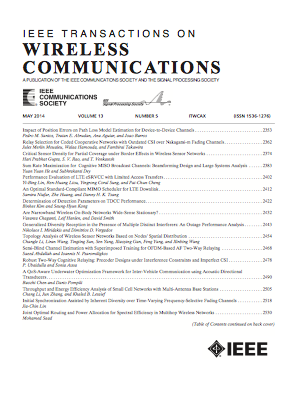Resource Allocation and Load Balancing for Beam Hopping Scheduling in Satellite-Terrestrial Communications: A Cooperative Satellite Approach
IF 10.7
1区 计算机科学
Q1 ENGINEERING, ELECTRICAL & ELECTRONIC
引用次数: 0
Abstract
Satellite-terrestrial communications based on mega low-Earth orbit (LEO) constellations enable extensive coverage and high data rates. However, the communication performance is significantly impacted by the non-uniform traffic distribution and the substantial interference caused by dense satellites. Therefore, in this paper, a multi-satellite cooperation architecture for satellite-terrestrial communications is proposed in LEO satellite constellations. Specifically, beam hopping (BH) and resource allocation enable a flexible solution for the non-uniform geographical distribution of communications, and are optimized to improve communication performance and avoid both intra- and inter-satellite interference in satellite-terrestrial communications. Moreover, load balancing via inter-satellite link (ISL) is implemented to further enhance the communication performance. Consequently, the overall problem for maximizing the network throughput and ensuring the latency metric is formulated, and then decomposed into three sub-problems: deep reinforcement learning (DRL) based BH scheduling, resource allocation with multi-satellite cooperation, and load balancing via ISLs. Specifically, DRL is utilized to determine the real-time BH pattern, and the resource allocation among beams is implemented by the majorization-minimization algorithm. Furthermore, for varying input traffic loads, different objectives for load balancing are established and solved by quadratic transformation and hybrid block successive approximation algorithm. Simulation results demonstrate that the proposed method outperforms other existing methods. Meanwhile, it obtains an 18.45% improvement in throughput compared with the benchmark without optimization, while the latency metric for satellite-terrestrial communications is also reduced by the proposed method.星地通信中跳波束调度的资源分配与负载均衡:一种卫星合作方法
基于超级低地球轨道(LEO)星座的卫星-地面通信能够实现广泛的覆盖和高数据速率。然而,由于业务分布不均匀和密集卫星造成的大量干扰,通信性能受到很大影响。为此,本文提出了一种低轨卫星星座中星地通信的多星合作架构。具体而言,波束跳变(BH)和资源分配为通信的非均匀地理分布提供了灵活的解决方案,并对其进行了优化,以提高通信性能,避免星地通信中的星内和星间干扰。此外,通过星间链路(ISL)实现负载均衡,进一步提高通信性能。在此基础上,提出了最大化网络吞吐量和保证时延指标的总体问题,并将其分解为基于深度强化学习(DRL)的BH调度问题、基于多卫星协作的资源分配问题和基于isl的负载均衡问题三个子问题。具体来说,利用DRL确定实时波束方向图,通过最大-最小算法实现波束间的资源分配。针对不同的输入流量负载,建立了不同的负载均衡目标,并采用二次变换和混合块逐次逼近算法求解。仿真结果表明,该方法优于现有方法。同时,与未经优化的基准算法相比,吞吐量提高了18.45%,同时降低了星地通信的延迟指标。
本文章由计算机程序翻译,如有差异,请以英文原文为准。
求助全文
约1分钟内获得全文
求助全文
来源期刊
CiteScore
18.60
自引率
10.60%
发文量
708
审稿时长
5.6 months
期刊介绍:
The IEEE Transactions on Wireless Communications is a prestigious publication that showcases cutting-edge advancements in wireless communications. It welcomes both theoretical and practical contributions in various areas. The scope of the Transactions encompasses a wide range of topics, including modulation and coding, detection and estimation, propagation and channel characterization, and diversity techniques. The journal also emphasizes the physical and link layer communication aspects of network architectures and protocols.
The journal is open to papers on specific topics or non-traditional topics related to specific application areas. This includes simulation tools and methodologies, orthogonal frequency division multiplexing, MIMO systems, and wireless over optical technologies.
Overall, the IEEE Transactions on Wireless Communications serves as a platform for high-quality manuscripts that push the boundaries of wireless communications and contribute to advancements in the field.

 求助内容:
求助内容: 应助结果提醒方式:
应助结果提醒方式:


